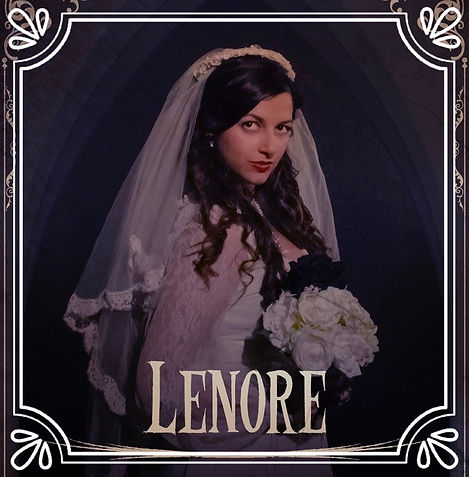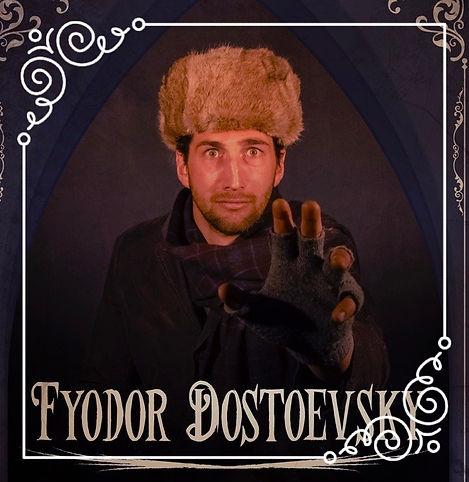Happy Mystery Invite Only Casual Dinner Party/Gala For Friends PotLuck

Edgar Allan Poe
Writer (1809–1849)
American writer, poet and critic Edgar Allan Poe is famous for his tales and poems of horror and mystery, including "The Fall of the House of Usher," "The Tell-Tale Heart" and "The Raven."
Who Was Edgar Allan Poe?
Edgar Allan Poe (January 19, 1809 to October 7, 1849) was an American writer, poet, critic and editor best known for evocative short stories and poems that captured the imagination and interest of readers around the world. His imaginative storytelling and tales of mystery and horror gave birth to the modern detective story. Many of Poe’s works, including “The Tell-Tale Heart” and “The Fall of the House of Usher,” became literary classics. Some aspects of Poe’s life, like his literature, is shrouded in mystery, and the lines between fact and fiction have been blurred substantially since his death. Continue reading

"Lenore" is a poem by the American author Edgar Allan Poe. It began as a different poem, "A Paean", and was not published as "Lenore" until 1843.
The poem discusses proper decorum in the wake of the death of a young woman, described as "the queenliest dead that ever died so young". The poem concludes: "No dirge shall I upraise,/ But waft the angel on her flight with a paean of old days!" Lenore's fiancé, Guy de Vere, finds it inappropriate to "mourn" the dead; rather, one should celebrate their ascension to a new world. Unlike most of Poe's poems relating to dying women, "Lenore" implies the possibility of meeting in paradise.
The poem may have been Poe's way of dealing with the illness of his wife Virginia. The dead woman's name, however, may have been a reference to Poe's recently dead brother, William Henry Leonard Poe.
Poetically, the name Lenore emphasizes the letter "L" sound, a frequent device in Poe's female characters including "Annabel Lee", "Eulalie", and "Ulalume".

"Annabel Lee" is the last complete poem composed by American author Edgar Allan Poe. Like many of Poe's poems, it explores the theme of the death of a beautiful woman. The narrator, who fell in love with Annabel Lee when they were young, has a love for her so strong that even angels are envious. He retains his love for her even after her death. There has been debate over who, if anyone, was the inspiration for "Annabel Lee". Though many women have been suggested, Poe's wife Virginia Eliza Clemm Poe is one of the more credible candidates. Written in 1849, it was not published until shortly after Poe's death that same year.
The poem's narrator describes his love for Annabel Lee, which began many years ago in a "kingdom by the sea". Though they were young, their love for one another burned with such an intensity that angels became envious. It is for that reason that the narrator believes the seraphim caused her death. Even so, their love is strong enough that it extends beyond the grave and the narrator believes their two souls are still entwined. Every night, he dreams of Annabel Lee and sees the brightness of her eyes in the stars. Every night he lies down by her side in her tomb by the sea.
.

Ernest Hemingway (1899-1961), born in Oak Park, Illinois, started his career as a writer in a newspaper office in Kansas City at the age of seventeen. After the United States entered the First World War, he joined a volunteer ambulance unit in the Italian army. Serving at the front, he was wounded, was decorated by the Italian Government, and spent considerable time in hospitals. After his return to the United States, he became a reporter for Canadian and American newspapers and was soon sent back to Europe to cover such events as the Greek Revolution

Charlotte Brontë was an English 19th century writer whose novel Jane Eyreis considered a classic of Western literature.
Synopsis
Born on April 21, 1816, in Thornton, Yorkshire, England, Charlotte Brontë worked as a teacher and governess before collaborating on a book of poetry with her two sisters, Emily and Anne, who were writers as well. In 1847, Brontë published the semi-autobiographical novel Jane Eyre, which was a hit and would become a literary classic. Her other novels included Shirley and Villette. She died on March 31, 1855, in Haworth, Yorkshire, England.

H.G. Wells, in full Herbert George Wells, (born Sept. 21, 1866, Bromley, Kent, Eng.—died Aug. 13, 1946, London), English novelist, journalist, sociologist, and historian best known for such science fiction novels as The Time Machine and The War of the Worlds and such comic novels as Tono-Bungay and The History of Mr. Polly.

Emily Dickinson
Writer, Poet (1830–1886)
Emily Dickinson was a reclusive American poet. Unrecognized in her own time, Dickinson is known posthumously for her innovative use of form and syntax.
Who Was Emily Dickinson?
Born on December 10, 1830, in Amherst, Massachusetts, Emily Dickinson left school as a teenager, eventually living a reclusive life on the family homestead. There, she secretly created bundles of poetry and wrote hundreds of letters. Due to a discovery by sister Lavinia, Dickinson's remarkable work was published after her death—on May 15, 1886, in Amherst—and she is now considered one of the towering figures of American literature.

George Eliot was the pen name of Mary Ann Evans, one of the leading English novelists of the 19th century. Her novels, most famously 'Middlemarch', are celebrated for their realism and psychological insights.
George Eliot was born on 22 November 1819 in rural Warwickshire. When her mother died in 1836, Eliot left school to help run her father's household. In 1841, she moved with her father to Coventry and lived with him until his death in 1849. Eliot then travelled in Europe, eventually settling in London.

Agatha Christie
Author, Playwright (1890–1976
Agatha Christie was a mystery writer who was one of the world's top-selling authors with works like Murder on the Orient Express and The Mystery of the Blue Train.
Synopsis
Born on September 15, 1890, in Torquay, England, Agatha Christie published her first novel, The Mysterious Affair at Styles, in 1920, and went on to become one of the most famous writers in history, with mysteries like Murder at the Vicarage, Partners in Crime and Sad Cypress. She sold billions of copies of her work, and was also a noted playwright and romance author. She died on January 12, 1976.

Mary Shelley
Author (1797–1851)
English writer Mary Shelley is best known for her horror novel Frankenstein, or the Modern Prometheus (1818). She was married to poet Percy Bysshe Shelley.
Synopsis
Mary Shelley was born on August 30, 1797, in London, England. She married poet Percy Bysshe Shelley in 1816. Two years later, she published her most famous novel, Frankenstein. She wrote several other books, including Valperga (1823), The Last Man (1826), the autobiographical Lodore (1835) and the posthumously published Mathilde. Shelley died on February 1, 1851, in London, England.

Fyodor Dostoyevsky
Author (1821–1881)
Russian writer Fyodor Dostoyevsky wrote the classics Crime and Punishment and The Brothers Karamazov. His work explored psychology and existentialism.
Synopsis
Born Nov. 11, 1821 in Moscow, Russia, Fyodor Dostoyevsky was educated at home until 1833. He studied to be a military engineer, but shortly after graduating decided to become a writer. He experienced traumatic events, including a mock execution and exile. His work explored the human condition and is credited with shaping existentialism. Crime and Punishment is one of his most well-known novels.

Oscar Wilde
Writer (1854–1900)
Author Oscar Wilde was known for his acclaimed works including The Picture of Dorian Gray and The Importance of Being Earnest, as well as his brilliant wit, flamboyant style and infamous imprisonment for homosexuality.
Synopsis
Born on October 16, 1854 in Dublin, author, playwright and poet Oscar Wilde was a popular literary figure in late Victorian England, known for his brilliant wit, flamboyant style and infamous imprisonment for homosexuality. After graduating from Oxford University, he lectured as a poet, art critic and a leading proponent of the principles of aestheticism. In 1891, he published The Picture of Dorian Gray, his only novel which was panned as immoral by Victorian critics, but is now considered one of his most notable works. As a dramatist, many of Wilde’s plays were well received including his satirical comedies Lady Windermere's Fan (1892), A Woman of No Importance (1893), An Ideal Husband (1895) and The Importance of Being Earnest (1895), his most famous play. Unconventional in his writing and life, Wilde’s affair with a young man led to his arrest on charges of "gross indecency" in 1895. He was imprisoned for two years and died in poverty three years after his release at the age of 46.

Louisa May Alcott
Author (1832–1888)
Louisa May Alcott was an American author who wrote the classic novel 'Little Women,' as well as various works under pseudonyms.
Synopsis
Louisa May Alcott was born on November 29, 1832, in Germantown, Pennsylvania. Henry David Thoreau and Ralph Waldo Emerson were family friends. Alcott wrote under various pseudonyms and only started using her own name when she was ready to commit to writing. Her novel Little Women gave Louisa May Alcott financial independence and a lifetime writing career. She died in 1888.

Anne Bronte
Relatively little is known about Anne Brontë's life. Records indicate where she was and suggest general outlines of what she was doing; her published works suggest something of her experience and beliefs; but few records survive of her daily life and feelings, in her own words or those of witnesses. The few cases in which her own recorded impressions can be compared with those of her sisters, Charlotte and Emily, suggest that their perceptions of Anne are not reliable guides to Anne's feelings. Any biography is a fragile patchwork of facts and possibilities, sewn together with inferences, suppositions, and hopes.
